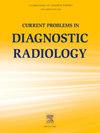Musculoskeletal imaging fellowship program directors: A study of educational paths, and scholarly engagement in the United States
IF 1.5
Q3 RADIOLOGY, NUCLEAR MEDICINE & MEDICAL IMAGING
引用次数: 0
Abstract
Purpose
The overall aim of the study is to analyze and provide a comprehensive understanding of the demographics, educational backgrounds, and scholarly activities of musculoskeletal imaging fellowship program directors across the United States.
Methods
A list of all members of the Society of Skeletal Radiology was obtained and musculoskeletal imaging fellowship program directors across the US were included. Publicly available online sources were used to gather demographic and educational information about each musculoskeletal imaging fellowship program director, which included the online curriculum vitae from the program websites, Health Grades, Doximity, and Elsevier's Scopus database. Demographic and educational data including age, gender, educational background (medical school, residency, fellowship), additional degrees, academic rank, prior leadership positions, and metrics of scholarly activity were recorded. Fellowships in diagnostic musculoskeletal radiology along with additional degrees were recorded. A two-tailed unpaired t-test was used to calculate the difference between means of scholarly activity between male and female PDs.
Results
In this study encompassing 92 programs across the United States, the majority (88) were dedicated to pure Musculoskeletal (MSK) Imaging Fellowship, while one each offered combined training in MSK and Body Imaging, MSK, and Emergency Imaging, MSK Sports, and Interventional Spine, and Pediatric MSK Imaging. Program directors were identified for 90 out of 92 programs, revealing a regional distribution of 29 in the South (31.5 %), 24 in the North East (26.1 %), 20 in the Midwest (21.74 %) and 19 in the West (20.65 %). Gender analysis unveiled a predominantly male representation, with 71 male directors compared to 17 female directors, while age ranged from 30 to 70 years, with a mean age of 47.17 ± 7.4 years. Medical school backgrounds predominantly featured MD degrees (80), followed by IMG (7) and DO (4) degrees, with the most common IMG source being India. Faculty positions were mainly distributed among Assistant Professors (35), Associate Professors (32), and Professors (11). Research output metrics showcased a mean of 41.943 publications and an h-index of 10.625. Extra degrees were obtained by 31 directors, with common additions being other fellowships, MBAs, MS degrees, and PhDs. Notably, some directors held previous or current leadership positions, while a few had completed residencies outside of Radiology or pursued fellowships beyond MSK Imaging.
Conclusion
Musculoskeletal imaging fellowship program directors across the United States are predominantly male, with approximately 8 % having graduated from international medical schools. The most common training pathway for these directors is completing a diagnostic radiology residency followed by a musculoskeletal radiology fellowship. This study highlighted the gender disparity within this leadership group and emphasized the diverse educational backgrounds that contribute to the field of musculoskeletal imaging.
肌肉骨骼成像研究金项目主任:美国教育路径和学术参与研究。
目的:本研究的总体目标是分析并全面了解全美肌肉骨骼成像研究金项目主任的人口统计学、教育背景和学术活动:我们获得了一份骨骼放射学会所有会员的名单,并将全美的肌肉骨骼成像研究金项目主任纳入其中。利用公开的在线资源收集每位肌肉骨骼成像研究金项目主任的人口统计学和教育信息,其中包括项目网站、Health Grades、Doximity 和 Elsevier 的 Scopus 数据库中的在线简历。记录的人口统计学和教育数据包括年龄、性别、教育背景(医学院、住院医师、研究员)、其他学位、学术排名、曾担任的领导职务以及学术活动指标。此外,还记录了诊断性肌肉骨骼放射学研究员以及其他学位。采用双尾非配对 t 检验来计算男性和女性 PD 之间学术活动平均值的差异:在这项涵盖全美92个项目的研究中,大多数项目(88个)都是纯粹的肌肉骨骼(MSK)成像研究员项目,另有一个项目提供MSK和身体成像、MSK和急诊成像、MSK运动和介入脊柱以及儿科MSK成像的综合培训。在 92 个项目中,有 90 个项目的项目主任被确定,地区分布为南部 29 个(31.5%)、东北部 24 个(26.1%)、中西部 20 个(21.74%)和西部 19 个(20.65%)。性别分析显示,男性主任占绝大多数,男性主任 71 名,女性主任 17 名;年龄从 30 岁到 70 岁不等,平均年龄为 47.17 ± 7.4 岁。医学院背景主要是医学博士(80 人),其次是 IMG(7 人)和 DO(4 人),最常见的 IMG 来源地是印度。教职主要分布在助理教授(35)、副教授(32)和教授(11)中。研究成果指标显示,平均发表论文 41.943 篇,h 指数为 10.625。有 31 位主任获得了额外学位,常见的额外学位包括其他奖学金、工商管理硕士、硕士学位和博士学位。值得注意的是,一些主任曾担任或现任领导职务,还有一些主任完成了放射科以外的住院医师培训,或攻读了 MSK 成像以外的研究金:结论:全美肌肉骨骼成像研究金项目主任以男性为主,约有 8% 毕业于国际医学院。这些主任最常见的培训途径是先完成放射诊断住院医师培训,然后再完成肌肉骨骼放射研究员培训。这项研究突出了这一领导群体中的性别差异,并强调了为肌肉骨骼成像领域做出贡献的不同教育背景。
本文章由计算机程序翻译,如有差异,请以英文原文为准。
求助全文
约1分钟内获得全文
求助全文
来源期刊

Current Problems in Diagnostic Radiology
RADIOLOGY, NUCLEAR MEDICINE & MEDICAL IMAGING-
CiteScore
3.00
自引率
0.00%
发文量
113
审稿时长
46 days
期刊介绍:
Current Problems in Diagnostic Radiology covers important and controversial topics in radiology. Each issue presents important viewpoints from leading radiologists. High-quality reproductions of radiographs, CT scans, MR images, and sonograms clearly depict what is being described in each article. Also included are valuable updates relevant to other areas of practice, such as medical-legal issues or archiving systems. With new multi-topic format and image-intensive style, Current Problems in Diagnostic Radiology offers an outstanding, time-saving investigation into current topics most relevant to radiologists.
 求助内容:
求助内容: 应助结果提醒方式:
应助结果提醒方式:


